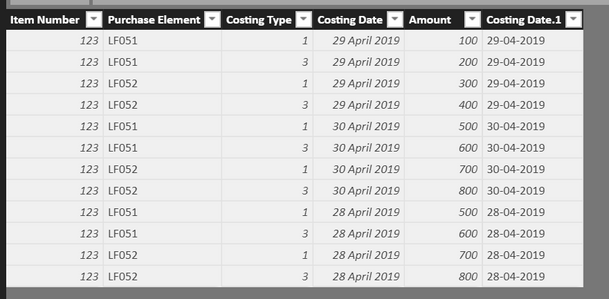- Power BI forums
- Updates
- News & Announcements
- Get Help with Power BI
- Desktop
- Service
- Report Server
- Power Query
- Mobile Apps
- Developer
- DAX Commands and Tips
- Custom Visuals Development Discussion
- Health and Life Sciences
- Power BI Spanish forums
- Translated Spanish Desktop
- Power Platform Integration - Better Together!
- Power Platform Integrations (Read-only)
- Power Platform and Dynamics 365 Integrations (Read-only)
- Training and Consulting
- Instructor Led Training
- Dashboard in a Day for Women, by Women
- Galleries
- Community Connections & How-To Videos
- COVID-19 Data Stories Gallery
- Themes Gallery
- Data Stories Gallery
- R Script Showcase
- Webinars and Video Gallery
- Quick Measures Gallery
- 2021 MSBizAppsSummit Gallery
- 2020 MSBizAppsSummit Gallery
- 2019 MSBizAppsSummit Gallery
- Events
- Ideas
- Custom Visuals Ideas
- Issues
- Issues
- Events
- Upcoming Events
- Community Blog
- Power BI Community Blog
- Custom Visuals Community Blog
- Community Support
- Community Accounts & Registration
- Using the Community
- Community Feedback
Register now to learn Fabric in free live sessions led by the best Microsoft experts. From Apr 16 to May 9, in English and Spanish.
- Power BI forums
- Forums
- Get Help with Power BI
- Desktop
- Two different dates slicing single visualisation
- Subscribe to RSS Feed
- Mark Topic as New
- Mark Topic as Read
- Float this Topic for Current User
- Bookmark
- Subscribe
- Printer Friendly Page
- Mark as New
- Bookmark
- Subscribe
- Mute
- Subscribe to RSS Feed
- Permalink
- Report Inappropriate Content
Two different dates slicing single visualisation
Hi ,
I have a table as shown in the screenshot .
Then it should compare the sum of the amount for each purchase element for each date that we select in the slicer.
Let the two compare measures be Compare 1 and Compare 2. So the requirement is that when I choose a date in slicer one and a Type in costing type slicer one
it should affect data in compare one . and when I choose the date and type in slicer two it should affect the sum in comparing 2.
For example :
If I choose 28th April 2019 and Type 1 in slicer 1 and 29th April 2019 and Type 3 in slicer two than it should show ,
sum of the amount of Type 1 on 28th april Vs sum of the amount of type 3 on 29th April n the same visualisations. Currently, if I am using two different dates or two different types it shows be blank data.



Any idea will be welcome. Please tell if the requirement is clear.
Thanks in advance.
Solved! Go to Solution.
- Mark as New
- Bookmark
- Subscribe
- Mute
- Subscribe to RSS Feed
- Permalink
- Report Inappropriate Content
Hi @Anonymous
I can create two measure to show values of comparing 1 and comparing 2.
First, create two tables
filte1 = CROSSJOIN(VALUES('Table'[type]),VALUES('Table'[date]))
filter2 = CROSSJOIN(VALUES('Table'[type]),VALUES('Table'[date]))
They have no relationship with others.
Then add "date" and "type" from two tables in slicers.
Create measures
compare1 = CALCULATE(SUM('Table'[amount]),FILTER(ALLEXCEPT('Table','Table'[item]),'Table'[type]=SELECTEDVALUE('filte1'[type])&&'Table'[date]=SELECTEDVALUE(filte1[date])))
compare2 = CALCULATE(SUM('Table'[amount]),FILTER(ALLEXCEPT('Table','Table'[item]),'Table'[type]=SELECTEDVALUE('filter2'[type])&&'Table'[date]=SELECTEDVALUE(filter2[date])))
Best Regards
Maggie
Community Support Team _ Maggie Li
If this post helps, then please consider Accept it as the solution to help the other members find it more quickly.
- Mark as New
- Bookmark
- Subscribe
- Mute
- Subscribe to RSS Feed
- Permalink
- Report Inappropriate Content
Hi @Anonymous
I can create two measure to show values of comparing 1 and comparing 2.
First, create two tables
filte1 = CROSSJOIN(VALUES('Table'[type]),VALUES('Table'[date]))
filter2 = CROSSJOIN(VALUES('Table'[type]),VALUES('Table'[date]))
They have no relationship with others.
Then add "date" and "type" from two tables in slicers.
Create measures
compare1 = CALCULATE(SUM('Table'[amount]),FILTER(ALLEXCEPT('Table','Table'[item]),'Table'[type]=SELECTEDVALUE('filte1'[type])&&'Table'[date]=SELECTEDVALUE(filte1[date])))
compare2 = CALCULATE(SUM('Table'[amount]),FILTER(ALLEXCEPT('Table','Table'[item]),'Table'[type]=SELECTEDVALUE('filter2'[type])&&'Table'[date]=SELECTEDVALUE(filter2[date])))
Best Regards
Maggie
Community Support Team _ Maggie Li
If this post helps, then please consider Accept it as the solution to help the other members find it more quickly.
- Mark as New
- Bookmark
- Subscribe
- Mute
- Subscribe to RSS Feed
- Permalink
- Report Inappropriate Content
@Anonymous
Hi,
Is your requirement to compare the total costing for two different date ranges?
Rgds,
Vivek
Helpful resources

Microsoft Fabric Learn Together
Covering the world! 9:00-10:30 AM Sydney, 4:00-5:30 PM CET (Paris/Berlin), 7:00-8:30 PM Mexico City

Power BI Monthly Update - April 2024
Check out the April 2024 Power BI update to learn about new features.

| User | Count |
|---|---|
| 113 | |
| 100 | |
| 78 | |
| 76 | |
| 52 |
| User | Count |
|---|---|
| 144 | |
| 109 | |
| 108 | |
| 88 | |
| 61 |

